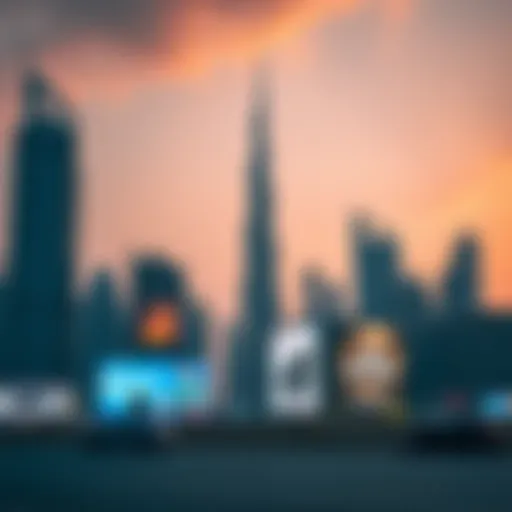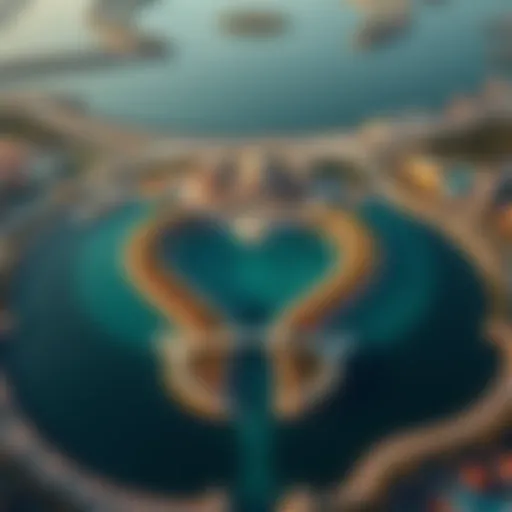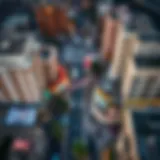Understanding Garhoud Intersection's Role in Dubai
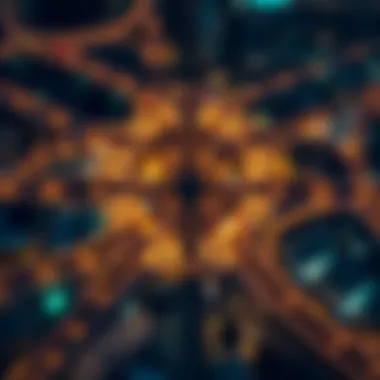

Intro
The Garhoud Intersection stands as a pivotal junction within Dubai's sprawling urban landscape. Its impact is not merely limited to traffic flow but extends into the realms of urban development and real estate dynamics. Given the city's ever-growing appeal as a global destination, understanding the nuances of this intersection becomes essential for investors, urban planners, and anyone keen on navigating Dubai's intricate road network.
In this article, we embark on a thorough exploration of what makes the Garhoud Intersection tick. By examining its historical context, current functionality, and future prospects, readers will gain valuable insights into how this intersection shapes and is shaped by its surroundings.
Through statistical analysis and observational data, we will delve into current market trends and investment opportunities related to this key area. This isn't just about bricks and mortar; it's about where the next wave of urban evolution is likely to occur, and how savvy investors can tap into that potential.
We invite you to join us on this journey. Whether you're an analytic mind aiming to unravel traffic patterns, a developer eyeing up-and-coming neighborhoods, or a real estate investor seeking high-return areas, there's something within these pages to enrich your understanding of the Garhoud Intersection and its broader implications.
Historical Perspective of Garhoud Intersection
The Garhoud Intersection represents more than just a junction in Dubai; it encapsulates the evolution of urban design and the intricate networks that underpin modern city life. Understanding its historical perspective is essential for grasping how it has shaped not only local traffic patterns but has also influenced broader trends in urban development. This intersection has been a focal point of connectivity, serving as a conduit for journeying individuals, while simultaneously impacting the growth of surrounding areas.
Early Development
In the early days of Dubai, Garhoud was just a small suburb. The dynamics of travel were straightforward, with minimal infrastructure catering to a growing population. The intersection, as we know it today, was not a twinkle in the eyes of urban planners. Back then, life was built around simplicity, and roads were often unpaved tracks leading into the desert. However, as the city began its journey towards globalization in the late 20th century, the importance of a robust transport infrastructure became apparent.
As more people flocked to the area, the planners pivoted towards creating an organized road network. The 1990s marked the beginning of significant changes. The development of the Garhoud Interchange was initiated to alleviate congestion and enhance connectivity. It was a time when Dubai’s transformation from a trading port to a bustling metropolis was gaining momentum. With more cars on the road, being stuck in traffic was becoming a norm, pushing authorities to rethink and escalate development plans.
Evolution Over Time
The Garhoud Intersection has undergone several transformations since its inception. By the turn of the millennium, Dubai was well on its way to becoming a global city, and the infrastructure continued to evolve in tandem. Significant advancements in engineering and technology allowed for the redesign and expansion of the intersection, with features that were not previously present.
As traffic volumes soared, the need for a multi-level interchange arose. The construction of new lanes and overpasses became necessary to prevent bottlenecks.
- The introduction of signalized intersections: This adjustment enhanced traffic flow, preventing delays that previously plagued commuters.
- Installation of smart traffic signals: This technology changed how traffic was managed, leading to more efficient use of time for drivers.
- Pedestrian-friendly enhancements: Upgrades included pedestrian bridges and dedicated crosswalks, acknowledging the importance of safe passage for foot traffic in such a bustling urban area.
The evolution didn’t stop at mere expansion. Environmental considerations began to influence design choices, leading to discussions about sustainability and aesthetic integration of green spaces. Today, the Garhoud Intersection isn't just functional; it's part of a larger urban tapestry that reflects Dubai's story of growth and change. Understanding this history offers invaluable insights for investors, urban planners, and anyone invested in the dynamics of Dubai as a city.
"The past shapes the present; the Garhoud Intersection is a testament to Dubai’s resilience and vision for the future."
As you delve into the subsequent sections, keep in mind how this historical context has laid the groundwork for the Garhoud Intersection’s current and potential future significance in urban planning.
Geographical Significance
Understanding the geographical significance of Garhoud Intersection is pivotal for a number of reasons. It serves as not just a transportation junction but as a crucial link in the larger framework of Dubai’s urban planning and development. The intersection's location effectively influences traffic patterns, accessibility to nearby areas, and the socioeconomic dynamics of its surroundings.
This area is situated strategically, connecting several key districts. With major roads converging at this point, the intersection facilitates the seamless flow of both vehicular and pedestrian traffic. As a gateway to various neighborhoods, it also acts as a catalyst for real estate expansion and urban development, making it a focal point for investors and urban planners alike.
Location Overview
Garhoud Intersection is nestled between several key locations in Dubai, making it a hub for connectivity. It links the bustling Deira district to the modern infrastructure of Dubai Airport, with major thoroughfares like the Airport Road and Sheikh Zayed Road intersecting right here.
The bridge itself is a remarkable structure, with multi-lane capacity designed to handle peak traffic. Each lane accommodates the diverse types of vehicles that traverse this crossroad—from private cars to public transportation, which includes buses and taxis. This ensures that the intersection remains a vital artery for the movement of goods and services throughout the city.
Adjacent Landmarks
The significance of Garhoud Intersection also stems from its proximity to vital landmarks:
- Dubai International Airport: Just a stone's throw away, this airport is one of the busiest in the world, thus amplifying the intersection’s importance. The airport brings a constant flow of tourists and business travelers, creating a need for efficient transport routes.
- Dubai Festival City: A renowned commercial and leisure destination, it draws shoppers and families alike. The proximity to this vibrant hub ensures that the intersection is frequented by a diverse crowd, thereby increasing its appeal as a prime location for businesses.
- Dubai Creek: The intersection stands near this historical waterway, providing easy access to picturesque landscapes and recreational spaces. This characteristic not only enhances the allure of the area but also influences its real estate dynamics.
- Ras Al Khor Wildlife Sanctuary: A not-so-far drive away, this ecological haven establishes a delicate balance between urban sprawl and nature. The intersection’s accessibility to such a sanctuary positions it favorably in terms of attracting environmentally-conscious developments.
Insight into these landmarks allows investors and urban planners to understand the potential opportunities and challenges that lie in the region . Given its strategic location and valuable adjacent assets, the area around Garhoud Intersection is ripe for both residential and commercial expansion.
Design and Infrastructure
The design and infrastructure of the Garhoud Intersection play a pivotal role in the overall efficiency of the Dubai road network. Every element, from the layout of the roads to the choice of materials used in construction, contributes to the seamless flow of traffic and the safety of its users. Understanding these aspects not only sheds light on the significance of this intersection but also offers insight for those interested in real estate investments and urban planning programs.
Traffic Flow Management
Efficient traffic flow management is foundational to the functionality of the Garhoud Intersection. Strategic design elements such as multiple lanes, synchronized traffic signals, and roundabouts help in smoothing out what could otherwise be chaotic traffic patterns, especially during peak hours. The intersection utilizes advanced traffic modeling techniques that predict congestion and allow for timely adjustments in signal timing, thereby managing both light and heavy traffic.
An essential feature of this management system is dedicated turning lanes. These allow vehicles to turn smoothly without blocking straight-moving traffic, reducing delays significantly. Additionally, real-time traffic monitoring systems are integrated, providing live data that can help optimize intersections dynamically. This can bring noticeable improvement during busy travel periods, allowing commuters to reach their destinations more promptly.
"Efficient infrastructure isn’t just a matter of aesthetics; it’s about facilitating everyday lives and enhancing connectivity."
Moreover, studies indicate that well-designed intersections not only enhance flow but also reduce travel times by a substantial margin. This flows directly into the overarching urban strategy of Dubai, which aims at minimizing traffic congestion, a hallmark of bustling metropolitan landscapes.
Safety Features
Safety features deeply entwined with the design of the Garhoud Intersection are perhaps one of the most critical considerations. The safety of both vehicular and pedestrian traffic is guaranteed through a meticulous approach to traffic layout. Features such as clearly marked pedestrian crossings, ample signage, and traffic lights are thoughtfully placed to ensure visibility and awareness.
In addition to visible safety measures, there's a robust implementation of technology that aids in accident prevention. Advanced surveillance cameras monitor real-time traffic behavior. This not only assists in identifying traffic violations but also aids in quick response times during accidents or emergencies. The incorporation of smart traffic lights that respond dynamically to traffic flow further enhances safety by reducing the chances of collisions.
To support the movement of cyclists and pedestrians, dedicated bike lanes and sidewalks have been integrated into the road design. This encourages a more sustainable approach to travel while ensuring that non-motorized road users have safe avenues to navigate the intersection.
In sum, the design and infrastructure at Garhoud Intersection serve as a model. Through thoughtful planning and implementation of traffic management systems complemented by a range of safety features, this intersection meets the demands of a growing urban area while ensuring accessibility and security for all who traverse its pathways.
For those looking deep into the urban planning of Dubai, examining the design principles used here might provide useful insights for future infrastructures globally.
Impact on Urban Development
The Garhoud Intersection is more than just a point where roads converge; it acts as a catalyst for urban evolution within Dubai. This strategic junction plays a vital role in shaping the urban fabric of the surrounding area by influencing commerce, quality of life, and overall growth patterns. The significance of the intersection extends beyond mere transportation; it serves as a crucial catalyst for both commercial and residential undertakings, making its impact on urban development profound.
Commercial Expansion
To understand the intersection’s influence on the commercial landscape, one must recognize that its accessibility directly correlates with economic vitality. Businesses flourish when they are situated near key transport arteries like Garhoud. This area has seen a surge in commercial ventures, ranging from retail outlets to restaurants, all leveraging the high traffic volumes that this junction attracts.
Several elements contribute to this commercial boom:
- Strategic Location: The intersection is ideally placed near major highways and residential enclaves, making it a prime spot for businesses targeting consumers from diverse demographics.
- Growing Demand: With Dubai’s population increasing, the need for shopping, dining, and services naturally follows. Many entrepreneurs view this junction as a goldmine for reaching potential customers.
- Infrastructure Support: The gradual improvements in road and transportation infrastructure around Garhoud facilitate smooth movement, enhancing business opportunities.
A noteworthy trend is the ongoing development of mixed-use spaces in the vicinity. These complexes not only house retail stores but also integrate living spaces, thereby attracting a larger audience throughout the day. In essence, the commercial prospects linked to the Garhoud Intersection are both immediate and long-term.
"The Garhoud Intersection is a vital crossroads that not only manages traffic but also orchestrates the growth of businesses that thrive on accessibility."
Residential Growth
In parallel to commercial expansion, the residential landscape around the Garhoud Intersection has also flourished. The convenience of living near a major intersection offers an alluring proposition for many residents. As the population swells, so do the opportunities for real estate development. Here are notable aspects affecting residential growth in this region:
- Affordability and Variety: The area features a mix of housing options, from apartments to villas, catering to diverse financial capacities. This variety allows new residents to choose homes that fit their lifestyles while remaining close to essential amenities.
- Community Appeal: Living within this hub means residents enjoy proximity to various facilities, such as schools, parks, and shopping centers. This aspect plays a significant role in attracting families and professionals alike.
- Future Developments: There’s a persistent interest in further residential projects near the intersection, indicating a clear understanding among developers that this area will continue to be in demand.
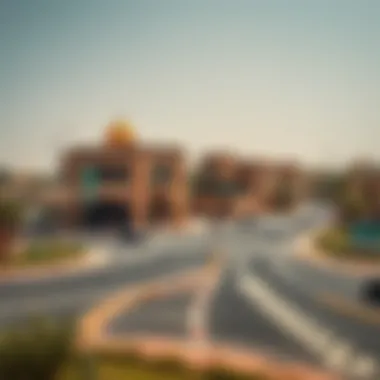

Garhoud's appeal as a residential hub is solidified by its unique blend of location and community facilities. As the landscape continues to evolve, so too does the potential for creating vibrant residential neighborhoods that respond to modern urban demands. The implications of development around the Garhoud Intersection persistently shape the lifestyle choices of residents, making it a focal point in Dubai’s urban transformation.
Traffic Patterns Analysis
Understanding traffic patterns at the Garhoud Intersection holds a significant position in influencing urban planning and real estate decisions. This analysis examines the flow of vehicles, peak hours, and public transport connectivity, all of which impact decision-making for investors and developers alike.
Peak Traffic Hours
Recognizing peak traffic hours is vital for anyone navigating Garhoud. The intersection sees its highest congestion during weekdays, particularly in the mornings from 7:00 AM to 9:30 AM and evenings from 5:00 PM to 7:30 PM. This daily rhythm can affect not just local commuters but also the schedules of businesses operating in the vicinity. During these hours, motorists often experience delays due to an increase in vehicle volumes, which can sharply hinder accessibility.
- Morning Rush: Commuters heading to work create a bottleneck that is often exacerbated by school runs.
- Evening Peak: Folks returning home after long workdays crowd the streets, making it essential for businesses to adjust their operating hours accordingly.
That said, there are considerations that can be harnessed from this data. Businesses positioned within or near Garhoud can strategize their operating hours to attract more visitors during off-peak times. It's a balancing act—understanding rush hours allows companies to adjust their services, like optimizing delivery schedules or offering early-bird discounts to lure customers before the congestion hits.
Influence of Public Transport
Public transport serves as a lifeline for many in Dubai, creating a multi-modal approach to commuting around the Garhoud Intersection. Integrated transportation options, such as buses and the metro, influence traffic patterns significantly. The area's accessibility is bolstered by the presence of nearby metro stations and bus stops, which are often bustling hubs during peak travel times.
- Metro Network: The Al Garhoud metro station connects commuters to key points across the city, easing pressure on road networks.
- Bus Services: Local bus services provide direct routes to the intersection, allowing those who prefer public transport to efficiently navigate crowded streets.
Interestingly, the efficient public transport system simplifies traffic congestion during peak hours. Studies have shown that areas with high public transport usage experience fewer vehicles on the road, contributing to smoother traffic flow. This promising intersection demonstrates how public transport infrastructure can significantly alleviate stress on road networks. Furthermore, investors might see opportunities in properties close to these public transport hubs due to increased demand from commuters seeking a balance of accessibility and convenience.
"Properly enhancing the public transport system has a ripple effect on the surrounding areas, creating a more vibrant and accessible community."
As we analyze traffic patterns and public transport influence at Garhoud Intersection, the insights gleaned unfurl a narrative of the area's evolving landscape. This understanding helps investors and analysts forecast the future of both real estate and urban planning in Dubai.
Surrounding Neighborhoods
The neighborhoods surrounding Garhoud Intersection play a crucial role in shaping the dynamics of the area. The accessibility and connectivity offered by this intersection have a substantial impact on local amenities, housing market trends, and community growth. Understanding these neighborhoods provides insights that are vital not only for residents but also for potential investors and urban planners looking to navigate the complexities of the Dubai real estate landscape.
Garhoud Area Overview
Garhoud itself is a vibrant area characterized by a mix of residential, commercial, and recreational spaces. It's not just a transit hub; it's a community in its own right. The neighborhood is known for its diverse population, encompassing various nationalities and cultures, making it a melting pot of traditions.
Key features include:
- Residential Units: The housing options in Garhoud range from high-end villas to more affordable apartments, appealing to families and young professionals alike.
- Community Facilities: Garhoud boasts parks, schools, and community centers, fostering a sense of belonging among residents. This aspect adds significant value, as families look for neighborhoods with robust community infrastructure.
- Shopping and Dining: The area hosts an array of dining establishments and shopping centers. From local eateries to international restaurants, there’s something for everyone.
The location is strategically chosen, offering proximity to Dubai International Airport, making it a prime spot for expatriates and travelers. The convenience of getting around, with major road networks branching off from the intersection, enhances the desirability of living in Garhoud, further driving its real estate potential.
Nearby Communities
Adjacent to the Garhoud area are several notable communities that contribute to the intersection's significance and overall appeal. These neighboring areas include:
- Al Rashidiya: Known for its quiet residential vibe, Al Rashidiya offers more spacious homes along with a mix of modest and luxurious amenities. The community is well-regarded for its family-friendly environment, with schools and parks that cater to children and youth.
- Deira: Just a stone's throw away, Deira serves as one of the oldest districts of Dubai, rich in history and bustling with markets. Its proximity to the Garhoud Intersection provides quick access, drawing in diverse visitors and cultivating local commerce.
- Airport Freezone: A significant economic hub, this area attracts businesses and professionals. The availability of commercial properties and the accessibility to the intersection make it a desirable location for enterprises.
By evaluating these nearby communities, investors can gain a better understanding of how Garhoud Intersection influences the surrounding environment, as well as the potential for growth in real estate. The interaction between these areas creates a vibrant tapestry that enriches life in Dubai and enhances the area's value.
Real Estate Implications
The Garhoud Intersection stands as a significant player in the dynamic real estate landscape of Dubai. Its strategic location and robust connectivity to major roadways not only facilitates the daily commute but also shapes the surrounding property market. Investors, buyers, and real estate agents are increasingly acknowledging the intersection's role in driving market trends and influencing property values.
Market Trends.
Over the last few years, the real estate market around the Garhoud Intersection has seen a considerable shift, driven primarily by urban development initiatives and infrastructure enhancements. Key trends include:
- Rising Property Values: As commercial establishments and residential complexes flourish in adjacent areas, property prices have seen an upward trajectory. The intersection’s accessibility makes it highly desirable for both businesses and families.
- Shift to Mixed-Use Developments: With the growing demand for convenience, there is a notable rise in mixed-use projects that integrate residential, commercial, and recreational spaces. This trend optimizes land use and caters to modern lifestyles.
- Increased Rental Demand: Properties near the Garhoud Intersection are witnessing heightened rental interest. The ease of access to public transport and key city areas attracts a wide array of tenants, including expatriates and young professionals committed to urban living.
The above trends signal a fluid, evolving market where understanding the relationship between the intersection and surrounding developments becomes essential for informed decision-making.
Investment Potential
Investing in real estate around the Garhoud Intersection presents unique opportunities. Several factors contribute positively to its investment viability:
- Strong Economic Growth: Dubai’s economy is thriving, and sectors such as tourism, trade, and technology are fueling expansion. This economic vigor translates directly into real estate demand, creating ripe conditions for investors.
- Government Initiatives: The local government is continually unveiling projects aimed at improving infrastructure and public services. Investments in smart mobility solutions and enhancements to road safety around the Garhoud Intersection enhance property attractiveness.
- Cultural and Social Impact: As a melting pot of diverse cultures, Dubai’s neighborhoods, such as Garhoud, foster a vibrant community. The cultural significance coupled with growing residential development posits favorable investment prospects.
In summary, the intersection not only enhances the movement of people but also nurtures a fertile ground for real estate investment, making it a pivotal focus for those looking to capitalize on Dubai's ongoing growth trajectory.
Challenges Faced
The Garhoud Intersection, like many major urban junctions, grapples with its fair share of challenges. Understanding these hurdles is paramount for urban planners, potential investors, and the community. Throughout this section, we will dissect key aspects, giving clarity on how these issues affect not just traffic patterns, but also urban development and lifestyle in surrounding areas.
Traffic Congestion
Traffic congestion is the bane of any bustling metropolis, and Garhoud is no exception. This intersection often sees a constant stream of vehicles, particularly during peak hours. Ever tried crossing the road only to realize that the green light feels more like a suggestion? Yeah, that’s Garhoud for you. The sheer volume of cars, buses, and trucks converging here leads to frustrating delays.
- Key Factors Contributing to Congestion:
- Rise in Population: The explosive growth of Dubai's population means more vehicles on the roads. With residents flocking to nearby neighborhoods, it’s a pebble tossed into a pond, sending ripples of traffic delays.
- Economic Activity: The Garhoud area is teeming with commercial establishments. More businesses often result in more delivery trucks and customer vehicles, contributing to the heavy traffic flow.
- Limited Road Space: Despite its significance, the available infrastructure has not fully kept pace with rising demands. This mismatch creates bottlenecks that make one wish for an instant teleportation device.
To mitigate this annoyance, city planners are looking into various traffic management strategies, like smart traffic lights that adapt based on real-time data. But until these changes are fully rolled out, everyday commuters are caught in the gridlock.
Urban Sprawl
On the flip side, urban sprawl is a significant challenge that can be linked back to the Garhoud Intersection's role as a crucial transport hub.
- What is Urban Sprawl? Urban sprawl refers to the uncontrolled expansion of urban areas. In Dubai, this phenomenon has been quite pronounced, with neighborhoods extending farther out from the city centre. Garhoud acts as a gateway to peripheral zones, which is great for access but not so much for organized development.
- Impacts of Sprawl:
- Infrastructural Strain: New developments springing up in the vicinity of Garhoud increase the strain on existing infrastructure. Roads and public transport systems not designed for such expansion can lead to further gridlock, elucidating the cycle of congestion.
- Environmental Concerns: More buildings, roads, and paved areas mean less green space. The ecological balance often gets disrupted, leading to adverse effects on local wildlife and migration patterns.
- Social Disconnect: As communities spread out, the sense of community can diminish. People living on the edges may find themselves isolated, distanced from amenities and social activities concentrated around the city core.
Urban sprawl is a double-edged sword. While it allows for growth and movement towards the outskirts, it brings with it a host of complications that the Garhoud Intersection must contend with as the city continues to expand.
"Understanding the challenges of traffic congestion and urban sprawl at Garhoud is essential for shaping the future of urban planning in Dubai—allowing for smarter designs and sustainable growth.”
In summary, while Garhoud Intersection is a lifeline of connectivity, the challenges it faces demand innovative solutions and serious attention from stakeholders. Whether it’s easing the flow of traffic or managing urban expansion, addressing these issues will play a critical role in the intersection's future and, by extension, the future of Dubai itself.
Future Developments
The future of the Garhoud Intersection is a topic of great significance in the ongoing discussion about urban growth and infrastructure in Dubai. This intersection not only facilitates traffic but also plays a crucial role in shaping the economic landscape. Understanding future developments at this strategic point is imperative for investors, urban planners, and local authorities alike, as it will influence trade, real estate values, and overall urban efficiency.
Planned Infrastructure Enhancements

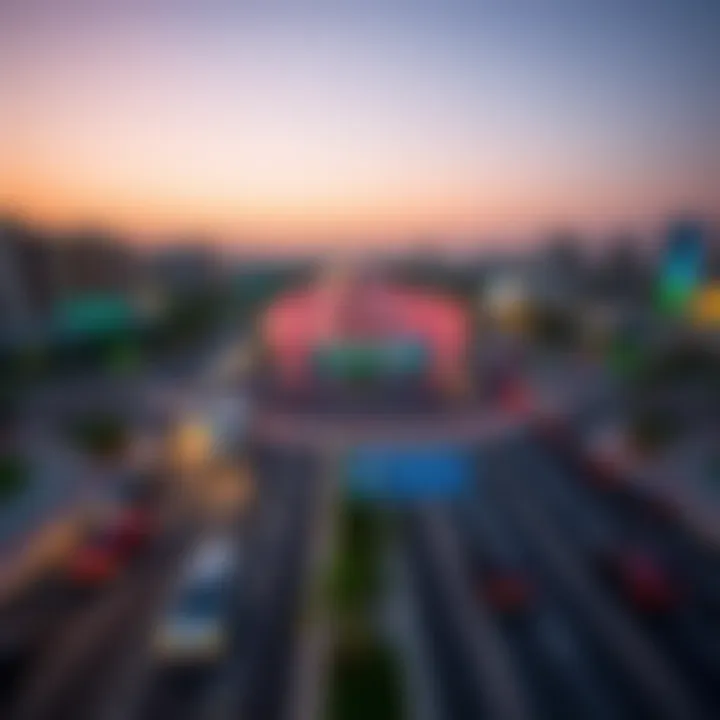
As Dubai continues to expand, there is an ongoing push to enhance the infrastructure surrounding the Garhoud Intersection. Several planned upgrades aim to improve traffic flow, increase safety, and foster economic growth. These enhancements may include:
- Smart traffic signals: Implementation of advanced signals that adjust according to real-time traffic conditions. This could significantly reduce congestion during peak hours, ensuring smoother circulation for all road users.
- Dedicated bus and taxi lanes: Introduced to streamline public transport options at the intersection, making it easier for commuters to access major destinations without interference from private vehicle traffic.
- Pedestrian-friendly designs: By integrating expanded walkways and pedestrian bridges, the overall accessibility and safety of the area for foot traffic improve. This is essential in a city where walking and cycling are becoming more popular as transportation choices.
These infrastructure enhancements not only aim to alleviate current traffic issues but also provide a foundation for future urban development, ensuring that the Garhoud area can handle an increasing population and vehicle count.
Long-Term Urban Planning Goals
The long-term vision for the Garhoud Intersection is closely tied to Dubai's ambitious urban planning initiatives. Several key goals can be highlighted:
- Sustainability Practices: Emphasizing environmental responsibility, future developments will prioritize sustainable materials and designs, promoting eco-friendly transportation options and reducing the carbon footprint of the area.
- Integration with larger transport networks: Plans are underway to ensure that Garhoud connects seamlessly with the future metro lines and express buses, thereby facilitating smoother transit for commuters traveling to and from various parts of the city.
- Revitalization of surrounding neighborhoods: The idea is not only about traffic management; urban planners are also looking at opportunities to enhance the surrounding communities. Initiatives may include mixed-use developments that blend residential spaces with commercial opportunities to create vibrant local economies.
By keeping the focus on long-term goals, stakeholders can ensure that Garhoud remains a dynamic and functional hub, adapting to evolving needs and fostering growth for years to come.
In summary, the future developments at the Garhoud Intersection promise to shape not just how traffic flows but also how communities flourish. For investors and stakeholders, these changes provide fertile ground for opportunity, urging a keen eye on the real estate and infrastructure landscape in this vital part of Dubai.
Comparative Analysis
The comparative analysis section serves as a pivotal piece in understanding the significance of Garhoud Intersection within the broader context of both Dubai and global urban planning practices. By examining this intersection alongside similar structures in the city and analyzing lessons gleaned from international examples, we can shed light on its unique attributes and operational challenges. This nuanced perspective is not only critical for policymakers but also provides a treasure trove of insights for investors and urban planners eager to capitalize on the growing dynamics of this region.
Similar Intersections in Dubai
Dubai, a city known for its ambitious infrastructures, holds several intersections worthy of comparison to the Garhoud Intersection. Key examples include:
- Al Garhood Intersection: This intersection shares proximity with the Garhoud area and deals with similar traffic challenges. Analyzing its design can offer insights into how different traffic flow strategies can be effectively implemented.
- Sheikh Zayed Road Interchange: Often buzzing with heavy traffic, it displays effective management through smart technology and multiple lanes. The techniques used here could serve as benchmarks for enhancements at Garhoud.
- Dubai Marina Interchange: Focused more on balancing traffic with pedestrian access, this intersection raises questions about how considerations for foot traffic can be integrated intelligently, a point crucial for the urban planners looking at Garhoud.
Drawing parallels from these intersections helps uncover patterns and creative solutions that can be adapted. It’s not just about the roads; understanding the environment, public transport connectivity, and pedestrian safety are essential elements that must be considered.
Lessons from Global Urban Centers
Examining global urban centers such as New York City, Tokyo, and London reveals a myriad of lessons applicable to Dubai’s own urban challenges.
- Traffic Management Strategies: In New York, the open data policies have led to improved traffic management, showcasing how data transparency can optimize flow and reduce congestion. Implementing a similar strategy in Dubai could provide valuable real-time insights into traffic patterns.
- Integration of Public Transport: Cities like Tokyo excel in seamlessly merging various forms of public transport systems, making it easy for commuters to switch modes. This model could inspire enhancements around the Garhoud Intersection, possibly connecting metro stations and bus stops more effectively to ease the commuter burden.
- Green Initiatives: London’s emphasis on green corridors demonstrates how sustainability can be pivotally integrated into urban planning. These eco-friendly approaches could help foster local fauna and flora while enhancing the aesthetic value of the area around Garhoud.
Each lesson from these global cities offers a framework that could be adapted to local needs alongside Garhoud’s unique context. In summation, a comparative analysis provides an essential lens to not only critique but also innovate on existing urban structures in Dubai, particularly Garhoud Intersection, making it a crucial area of focus for current and future developments.
Environmental Considerations
The significance of environmental considerations in the context of the Garhoud Intersection transcends mere traffic management; it extends into the broader realm of sustainable urban planning. As one of the busiest intersections in Dubai, understanding its environmental impact is crucial not only to mitigate potential harm but also to enhance the area's durability and livability. Developers, investors, and residents alike are becoming increasingly aware that a well-planned urban environment takes into account sustainability and ecological preservation. Integrating environmental considerations opens avenues for long-term benefits.
Sustainability Initiatives
Sustainability initiatives around the Garhoud Intersection reflect a growing commitment to balanced urban development. These initiatives are multifaceted, involving strategies that minimize carbon footprints and improve energy efficiency. For instance, the incorporation of green spaces and pedestrian-friendly walkways not only beautifies the area but also contributes to reducing heat islands, which is particularly relevant in the hot climate of Dubai.
- Green Infrastructure: Elements such as permeable pavements and rain gardens help in managing stormwater runoff, which is vital in maintaining local water quality.
- Renewable Energy: Projects have introduced solar-powered traffic lights and street lighting, demonstrating a shift towards reducing reliance on non-renewable energy sources.
- Community Engagement: Local stakeholders are often invited to participate in decision-making processes related to environmental policies. This helps cultivate a sense of responsibility and shared purpose among residents and business owners.
Implementing such initiatives not only enhances the environmental integrity of the Garhoud Intersection but also attracts a demographic keen on sustainable living, which could translate into heightened demand in the real estate market.
Impact on Local Ecology
The ecological footprint of an urban area is often underestimated, especially at significant crossroads like Garhoud Intersection. The intersection serves as a critical juncture that shapes not only traffic patterns but also local ecosystems. Here are some key points on its environmental impact:
- Habitat Disruption: The construction and ongoing expansion of roads can lead to habitat fragmentation for local wildlife. Understanding this impact is essential for mitigating adverse effects on biodiversity.
- Air Quality: Increased traffic volume raises concerns over air pollution levels, affecting both human health and local flora. Continuous monitoring and proactive measures are crucial for managing emissions.
- Noise Pollution: Urban noise can disrupt the natural behaviors of animals and the quality of life for residents. It's needed to incorporate sound barriers and vegetation to buffer these effects.
The integration of thorough environmental assessments is not just good practice; it is essential for fostering a resilient urban ecosystem.
By addressing these concerns head-on, urban planners and policymakers can work towards creating a harmonious balance between urban growth and ecological preservation. Every effort made here resonates outwards, influencing the surrounding neighborhoods and contributing to a more sustainable urban landscape overall.
Through these insights into sustainability initiatives and ecological impacts, it becomes evident that the Garhoud Intersection is a microcosm of the larger challenges and opportunities within urban planning in Dubai. As the city continues to develop, maintaining a focus on environmental considerations must remain a priority.
Community Response
The role of community response in the context of the Garhoud Intersection goes beyond mere public opinion; it shapes the way urban developments are proposed and realized. The feedback from locals helps city planners and investors align their projects with the genuine needs and aspirations of the people who actually live there. Understanding community sentiment is paramount, as it influences both the usage of the intersection and the broader ramifications on urban development.
Public Perception
Public perception of the Garhoud Intersection can be characterized by both appreciation for its connectivity and frustration stemming from traffic congestion. For many residents and commuters, this intersection serves as a lifeline, linking diverse neighborhoods and facilitating easy movements across the city. However, the heavier the traffic becomes, the more voices are raised regarding safety and delays. According to local surveys, a significant number of residents express a desire for better signage and clearer traffic regulations to mitigate confusion during peak hours.
Some key aspects shaping public perception include:
- Accessibility: The ease of reaching destinations is often highlighted as a strong point.
- Safety Concerns: Frequent accidents at the intersection heighten worries about pedestrian safety and traffic management.
- Urban Aesthetics: Locals often contrast their experience with other intersections in Dubai, noting that aesthetics play a key role in their daily lives.
"The Garhoud Intersection is our gateway, but it feels like a bottleneck most days!" - A frequent commuter.
Local Initiatives for Improvement
Local initiatives aimed at improving the Garhoud Intersection have gained traction over the years. They range from community-led safety campaigns to proposals for infrastructure enhancements involving government collaboration. These initiatives not only bridge the communication gap between residents and policymakers but also foster a sense of ownership among locals.
Several initiatives that have emerged include:
- Community Workshops: Public forums that allow residents to voice their concerns and suggestions directly to urban planners.
- Safety Campaigns: Local groups have emerged to advocate for pedestrian crossings and speed limits, particularly emphasizing vulnerable road users such as children and the elderly.
- Real-Time Traffic Information: Efforts to establish digital information boards displaying real-time traffic updates, which can significantly ease commuter anxiety.
Advantages of these initiatives:
- Strengthened community ties through collective action.
- Enhanced awareness regarding traffic issues—beneficial for all stakeholders involved.
- Direct influence on urban policy leading to more effective solutions tailored to community needs.
The essence of community response remains pivotal, impacting how the Garhoud Intersection evolves and functions. By valuing and incorporating public sentiment, planners not only mitigate challenges but also harness opportunities to craft a more integrated urban environment.
Technological Integration
The integration of technology in urban landscapes cannot be overstated, especially in crucial areas like the Garhoud Intersection. In today’s fast-paced world, employing advanced technologies becomes necessary for enhancing traffic management, improving safety measures, and sustaining economic growth. As Dubai races toward its ambitious smart city goals, the intersection stands as a flagbearer for integrating cutting-edge solutions to tackle urban challenges effectively.
Smart Traffic Solutions
One of the hallmark achievements surrounding the Garhoud Intersection is the implementation of smart traffic solutions. These solutions are more than just buzzwords; they represent a shift in how traffic flows are managed. With advanced traffic signal systems that adapt in real-time to the actual traffic conditions, there’s less waiting for red lights and a smoother drive overall.
- Adaptive Traffic Signals: Unlike traditional systems that operate on fixed timing cycles, adaptive signals use sensors to gauge vehicle flow. This can lead to significant reductions in idle time, thereby alleviating congestion.
- Data Analytics: By collecting and analyzing data on traffic patterns, planners can make informed decisions about future infrastructure improvements. For investors and real estate developers, this means better predictions about accessibility and future value appreciation of surrounding properties.
"Adaptive traffic management systems have shown promising results in rehearsing real-time data to enhance urban mobility."
Future of Autonomous Vehicles
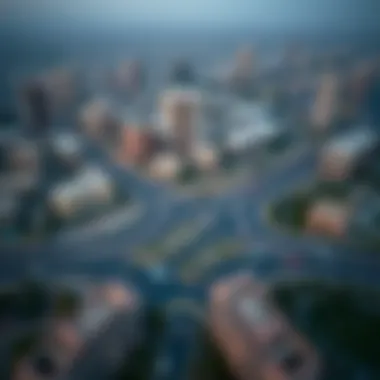
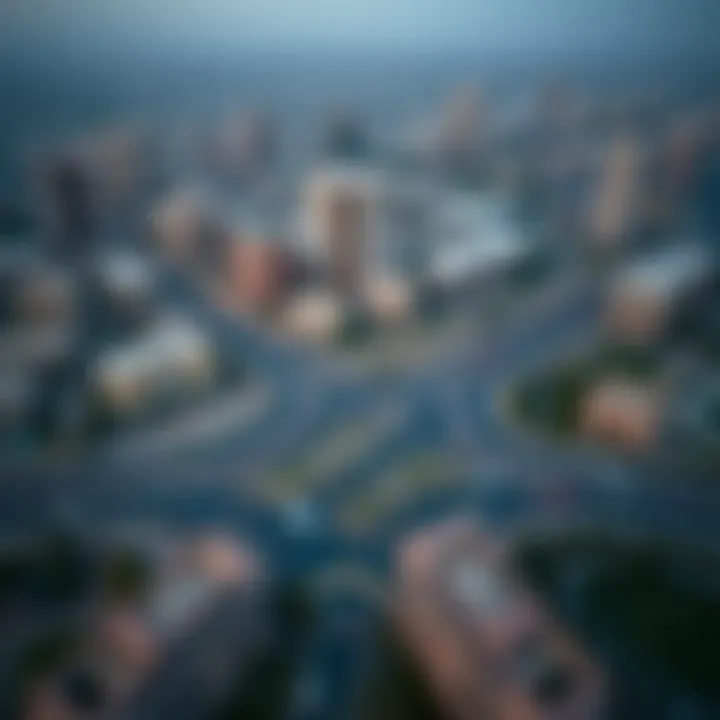
As we keep an eye on the horizon, the future of autonomous vehicles presents a whole new layer of possibilities for Garhoud Intersection. With advancements in AI, machine learning, and vehicle-to-everything (V2X) communication, the prospects are nothing short of exciting. These elements could potentially transform how we visualize road usage in the near future.
- V2X Communication: This technology enables vehicles to communicate with each other and the infrastructure around them. Imagine a scenario where an autonomous car could receive alerts about road conditions or traffic ahead, reducing accident risks significantly.
- Increased Accessibility: Autonomous vehicles promise not only to ease traffic but also to provide mobility solutions for people with disabilities and the elderly. Future developments might cater to these demographics, enhancing community inclusivity.
- Impact on Urban Planning: The rise of self-driving vehicles may shift the focus in urban planning from accommodating personal vehicles to creating pedestrian-friendly spaces. Additionally, investors could find opportunities here to adapt real estate developments to changing demand for housing that meets these new mobility needs.
For further reading on emerging transportation technologies, consider exploring resources from the U.S. Department of Transportation or academic insights from MIT's Urban Mobility Lab.
Understanding these advances now is key for anyone looking to invest in or better understand the future of urban environments.
Case Studies
The examination of case studies provides a rich context for understanding the multifaceted implications of the Garhoud Intersection within Dubai's urban milieu. These narratives are critical, offering a lens through which one can observe the successes and setbacks experienced by similar intersections across the globe. By scrutinizing these examples, investors, urban planners, and analysts can draw valuable lessons for future developments while recognizing the unique characteristics of Garhoud.
Successful Urban Interventions
Successful urban interventions often revolve around creative strategies that enhance mobility and community interaction, ensuring that transport hubs like Garhoud thrive. One notable example is the transformation of the Times Square area in New York City. Here, extensive pedestrianization not only improved traffic flow but also fostered a vibrant public space that attracted tourists and locals alike.
A careful review of Garhoud’s design principles could lead to similar outcomes. The integration of green spaces and mixed-use development in surrounding regions has shown to elevate both real estate values and social utilization. Furthermore, the introduction of traffic calming measures—such as roundabouts and speed bumps—has proven effective in reducing accidents and enhancing pedestrian safety. The importance of such initiatives cannot be overstated, as they lay the groundwork for more cohesive urban environments.
- Key elements in successful urban interventions include:
- Comprehensive stakeholder engagement
- Innovative traffic management solutions
- Enhancements in public transport infrastructure
- Promotion of community spaces
Failing Models and Lessons Learned
Looking at failing models helps in avoiding common pitfalls in urban planning. An example can be observed in Leichhardt, Australia, where poorly planned intersections have led to significant congestion and safety issues. Cars often block pedestrian pathways, discouraging foot traffic and making the areas less appealing for both residents and businesses.
In Garhoud’s context, it is vital to draw from these mistakes. Traffic patterns indicate that without proper signage and regulation, a chaotic flow is likely to ensue during peak hours. Implementing high-visibility crosswalks and synchronized traffic lights can prevent the kind of failures seen elsewhere.
Lessons from unsuccessful urban interventions highlight the need for caution:
- Failing to prioritize pedestrian safety can deter local commerce
- Neglecting maintenance can quickly erode initial investments
- Inflexible designs may stifle future adaptability
Learning from both successes and failures therefore presents a balanced perspective, ultimately benefiting the future planning and development strategies for Garhoud Intersection. This intersection holds further potential for advancement, directing traffic not only to its practical destinations but also as a unifying emblem of Dubai’s evolving urban identity.
Safety Metrics
Safety metrics play a pivotal role in understanding the performance and effectiveness of transportation systems, particularly in busy metropolitan areas like Dubai. In the case of the Garhoud Intersection, these metrics are not just numbers; they are indicators of how well the infrastructure protects its users. Analyzing these metrics helps city planners, local officials, and residents identify areas for improvement, showcasing their commitment to public safety.
A well-designed safety metric system incorporates several elements, starting with accident statistics, which are fundamental in determining where changes are necessary. The successful application of these metrics enhances operational efficiency, reduces the likelihood of accidents, and improves overall road safety.
Accident Statistics and Analysis
When delving into accident statistics at the Garhoud Intersection, one must look at data from various sources—police reports, traffic surveys, and public feedback. The intersection sees a healthy flow of traffic, and, understandably, this comes with its share of incidents. Over the past few years, data shows an upward trend in accidents during peak hours, indicating a pressing need for intervention.
Some notable findings include:
- Most Common Causes: Rear-end collisions and lane changes without signaling are among the frequent culprits.
- High-Risk Times: Late afternoons on weekdays often show a spike in accidents, coinciding with the rush hour.
- Severity of Incidents: While minor accidents predominate, some result in injury, emphasizing the need for immediate action.
Understanding these patterns can help construct a more comprehensive safety strategy. What's alarming is when one looks deeper into the analysis; many of these incidents could be prevented if proper safety measures were implemented. Here, the focus should not only be on reporting accidents but understanding their roots and developing strategies to decrease their occurrences.
Enhancing Road Safety Measures
A multifaceted approach is necessary to enhance road safety at the Garhoud Intersection. Simple measures can have a significant impact, helping to reduce accidents and improve driver behavior. Here are several recommendations:
- Infrastructure Improvements: Upgrading road signage and adding reflective paint can improve visibility during nighttime driving.
- Traffic Management Systems: Implementing advanced traffic flow technology can optimize signal timings. This will lead to smoother transitions, reducing driver frustration and the potential for hazardous maneuvers.
- Awareness Campaigns: It's also essential to educate the public through campaigns focused on defensive driving. Basic knowledge about traffic rules and safety can significantly lower accidents.
Improving road safety is not merely about the road itself but also involves the behavior of motorists. Data-driven initiatives can revolve around awareness campaigns, tailored specifically for the habits observed in the Garhoud area. Understanding that altering driver psychology can approach a holistic solution to traffic safety.
Collaboration between local residents, municipal engineers, and policymakers is critical in this laid-out strategy. Sharing insights creates a safer intersection for everyone in the community.
Cultural Significance
Cultural significance in the context of the Garhoud Intersection extends beyond the mechanics of roadways and traffic. This intersection symbolizes the convergence of diverse communities and economic pathways, becoming a microcosm of Dubai's broader tapestry. Understanding its cultural weight provides insight into how it shapes local identity, economic activity, and social dynamics.
Representation in Media
The media portrayal surrounding Garhoud Intersection is noteworthy. From local news outlets to social media platforms, it often serves as a backdrop in discussions about urban development and infrastructure in Dubai.
Photographers frequently gather here for striking visuals against the skyline, capturing the essence of city life. Documentaries sometimes showcase the intersection to emphasize Dubai's rapid urbanization. This visibility in media amplifies its importance, offering a lens into how the space is perceived not just by locals but also by visitors and investors.
In literature and film, Garhoud may not be a mainstream subject, yet it holds a place in narratives reflecting the city's evolution. Films that explore themes of migration and progress often highlight key intersections as pivotal points where lives meet and intertwine. These stories cultivate a sense of belonging among residents and promote a narrative of growth and aspiration.
Symbol of Urban Progress
Beyond its utilitarian role, the Garhoud Intersection stands as a beacon of urban progress. It represents the ambitious spirit of Dubai, embodying the aspirations of a city that has transformed from a small trading port into a global hub. It is emblematic of efficient design and engineering, where traffic flow is managed with precision and safety features implemented to ensure commuter well-being.
The expansion and enhancement projects over the years reflect not only economic growth but also a commitment to sustainability and accessibility. For instance, the integration of smart traffic solutions underscores a forward-thinking approach that aligns with global best practices, drawing eyes from around the world to this dynamic intersection. This commitment helps form the backbone of a metropolis, enabling ease of movement and connecting various sectors of the city.
Ultimately, the cultural significance of Garhoud Intersection lies in its ability to foster community ties. It serves as a vital junction that connects people, cultures, and economic opportunities, all while playing an essential role in the story of a city that continues to redefine itself. As such, it invites curiosity and examination, drawing in investors, residents, and tourists alike, making it an integral feature of Dubai's urban landscape.
"Garhoud Intersection is not just a point on a map; it's where countless stories intersect and thrive."
For more information about urban development in Dubai, you might find these resources useful:
- Wikipedia on Dubai
- Britannica
- Local News Outlets for current discussions.
In understanding these layers of cultural significance, stakeholders—be it investors, planners, or residents—can make informed decisions as they navigate the ever-changing landscape that surrounds the Garhoud Intersection.
End
The conclusion serves as a crucial wrap-up to our exploration of the Garhoud Intersection, which is much more than just a traffic hub in Dubai. Its significance reaches far and wide, touching on urban development, real estate trends, and community engagement. Particularly for investors and urban planners, understanding the intricate dynamics of the intersection provides valuable insights, essential in making informed decisions in their respective fields.
Summary of Findings
Throughout this article, we have traced the historical backdrop of Garhoud Intersection, observed its evolution, and assessed its geographical and infrastructural significance.
- Historical framework: From its early stages, the intersection has been pivotal in shaping the Dubai landscape. The evolution over time reflects not just infrastructural developments but also changing traffic patterns.
- Geographical context: Its strategic positioning makes it a prime location for commercial and residential growth.
- Design and infrastructure: A detailed analysis of traffic flow and safety features showcases the ongoing efforts made to ensure optimal functionality.
- Urban development impact: The intersection has been a catalyst for commercial expansion, influencing nearby real estate markets and attracting investors keen on tapping into its potential.
- Community and environmental insights: Understanding the local communities, their response to changes, and sustainability initiatives underscores the intersection's role as a social and environmental entity in Dubai.
Ultimately, these findings illustrate how the Garhoud Intersection plays an integral part in the overall urban architecture of Dubai, guiding decisions for potential investors and planners alike.
Final Thoughts on Future Prospects
Looking ahead, the future of Garhoud Intersection includes planned enhancements aimed at increasing its efficiency and accommodating the growing urban populace. Urban planners emphasize the need for:
- Continued investment in smart traffic management solutions to handle peak traffic hours more effectively.
- Infrastructure upgrades catering to the anticipated rise in autonomous vehicles, which will likely reshape how the intersection operates.
- Sustainability practices that ensure the environment is taken into account as this essential urban hub continues to evolve.
The trajectory of development around the Garhoud Intersection is promising. With proper planning and foresight, it stands to not only enhance traffic dynamics but also play a pivotal role in shaping the broader urban landscape of Dubai. Investors, agents, buyers, and analysts should keep a close watch on the developing patterns within this region, as it will likely yield substantial opportunities for growth.

